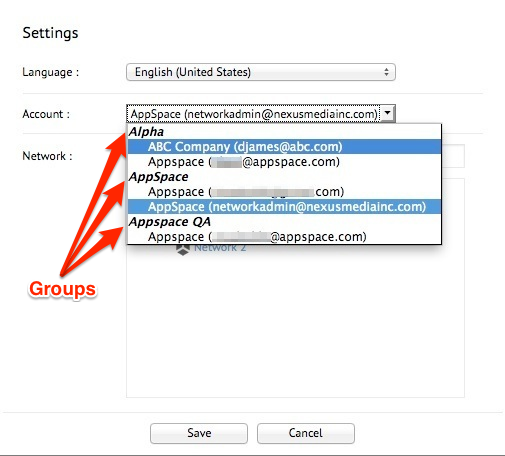Introduction
Important
This is only applicable for On-Premise deployments.
Multi-Tenancy is a core Add-on extension that provisions On-Premise instances of an Appspace Core server with multi-tenant capabilities. In essence, it is a configuration tool that enables you to leverage a single instance of Appspace Core to serve multiple client organizations (tenants), each with their own secure account. With a multi-tenant architecture, the software platform is designed to virtually partition its data and configuration, and each client organization works with a customized virtual application instance to manage their networks, users, devices, and apps.
Features:
- Serve multiple secure and independent accounts through a single Appspace Core instance
- Flexible provisioning of resources per account
- Enable up to 10 accounts
Prerequisites
- An active On-Premise Appspace Core instance (version 5.0.3.8 and above)
- A valid Appspace license key for installing the extension
- Windows Server user credentials on the Appspace server with local administrator privileges.
- Appspace Core user credential with Portal Administrator role.
- Basic knowledge of navigating Windows Server and IIS (Internet Information Services).
Multi-Tenancy vs. Virtualization
With virtualization, the components for running a specific instance (application platform, operating system, hardware, data storage) are separated for each client / set of clients, enabling each client application to appear to run on a separate physical machine. With multi-tenancy however, multiple clients share the same application platform, running on the same operating system, on the same hardware, with the same data-storage mechanism. The distinction between the clients is achieved during application design, thus clients do not share or see each others data. This results in easier client management as well as vast potential for cost savings, resource-wise.
Account Definition
An Account is a representation of a tenant in the Appspace Core environment. An Account is mapped to a client, and each account will consume 1 AAL (Additional Account License). The Multi-tenancy extension allows up to 10 AALs , which means that a single multi-tenanted server is able to accommodate up to 10 client accounts.
Account Types
An account can be categorized as one of the two types:
Full
- This is a standard account that can be applied to a permanent or fully active client.
Trial
- This is a time-limited account that will expire after the time period has ended.
- During the trial time duration, the account will have access to features that are unlocked by the administrator.
- A trial account can be converted into a full account.
Account Properties
An account needs to be tied to an owner (tenant) with the following properties recorded upon account registration:
- First name
- Last name
- Company
When configuring an account, the following base properties can be set:
- Language - sets the default language that is used in the user interface for the account.
- Time Zone - sets the default time zone for the account.
- Continent - sets the geographical continent for the account.
- Date Commenced - represents the start date that the account becomes active and ties directly into duration.
- Duration - active validity period of the account set in days, can be set to unlimited.
- Max Players - maximum number of player devices that can be registered, can be set to unlimited.
- Max Networks - maximum number of networks that can be created in the account, can be set to unlimited.
- Max Users - maximum number of users that can exist in the account, can be set to unlimited.
- Max Total Media Size - maximum total media size allowed for the entire account (content library total file size), can be set to unlimited.
- Max Applications - maximum number of applications that can be created in the account, can be set to unlimited.
- Max SmartHubs - maximum number of SmartHub ASE licenses that can be registered in the account, can be set to unlimited.
Account Group Definition
An Account must be scoped to an Account Group (will be simply referred to as Group from this point) before it can be created, easing the process of identification. In the context of multi-tenancy, a group represents a collection of accounts that are related to one another based on a common theme, such as a team, division, department or organization. After being created, the name of a Group (along with any accounts listed in it) will be displayed in the drop down menu of the account list when the Portal Administrator changes location, such as in the following sample (group names Alpha, Appspace and Appspace QA):

Common use cases for grouping a set of accounts by name are:
- Department/Division
- Network/Branch
- Physical Location
- Team